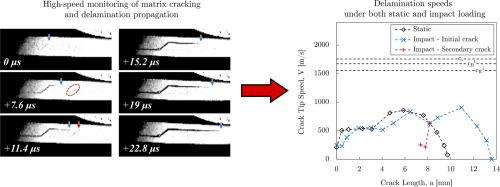International Journal of Solids and Structures ( IF 3.6 ) Pub Date : 2021-02-06 , DOI: 10.1016/j.ijsolstr.2021.01.032 Mirac Onur Bozkurt , Demirkan Coker

|
In this paper, experimental work to investigate the failure sequence in cross-ply CFRP beams under quasi-static and low-velocity impact (LVI) loadings is presented. [05/903]s CFRP beams with thick clustered plies are investigated for clear observation of damage mechanisms. A non-standard LVI test setup is designed and built in order to conduct line impact experiments and to allow in-situ observation of damage evolution using a high-speed camera. Full-field strain measurement on the visible edge prior to initial failure is performed with digital image correlation (DIC) analysis. In both static and dynamic loading cases, failure sequence is demonstrated to initiate in the middle 90° plies as a diagonal matrix crack leading to delaminations at the upper and lower 0/90 interfaces. Major diagonal matrix crack formation is shown to occur consistently at a local transverse shear strain peak in conjunction with a tensile transverse normal strain. Two additional distinct types of matrix damage, namely hairline cracks and micro-matrix cracks, are discovered in post-mortem examination. Delamination propagation in a composite beam subjected to line loading is monitored using high-speed photography at half-a-million frames-per-second for the first time. It is observed that, in both static and impact cases, delaminations are not only dynamic, but they also reach the same speed plateau of 850 – 900 m/s. We suggest that the experimental crack tip speed data can be used as a benchmark to fine-tune interlaminar damage models.
中文翻译:

原位在[0动态故障调查5 /90 3 ]小号CFRP下准静态和低速冲击载荷梁
在本文中,提出了研究准静态和低速冲击(LVI)荷载作用下的多层CFRP梁破坏顺序的实验工作。[0 5 /90 3 ]小号研究了具有厚簇层的CFRP梁,以清晰观察损坏机理。设计和构建了一个非标准的LVI测试装置,以便进行线路冲击实验,并允许使用高速摄像机现场观察损坏情况。使用数字图像相关性(DIC)分析在初始故障之前在可见边缘上进行全场应变测量。在静态和动态载荷情况下,都证明了失效顺序在中90°层中以对角矩阵裂纹的形式出现,从而导致在0/90上下界面处分层。主要对角基体裂纹的形成显示出在局部横向剪切应变峰值处与拉伸横向法向应变一致地发生。基质破坏的另外两种不同类型,在验尸中发现了发际线裂纹和微矩阵裂纹。第一次使用高速摄影以每秒50万帧的速度监视经受线负载的复合梁中的分层传播。可以看出,在静态和冲击情况下,分层不仅是动态的,而且达到了850 – 900 m / s的相同速度平稳状态。我们建议实验裂纹尖端速度数据可以用作微调层间损伤模型的基准。但它们也达到了850 – 900 m / s的相同速度平台。我们建议实验裂纹尖端速度数据可以用作微调层间损伤模型的基准。但它们也达到了850 – 900 m / s的相同速度平台。我们建议实验裂纹尖端速度数据可以用作微调层间损伤模型的基准。



























 京公网安备 11010802027423号
京公网安备 11010802027423号